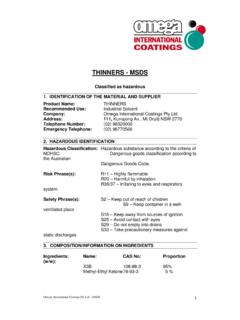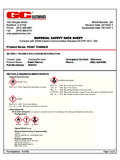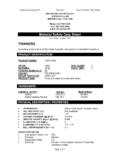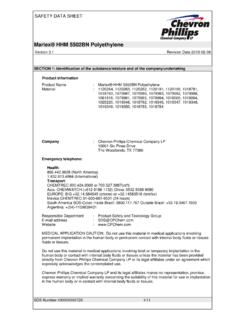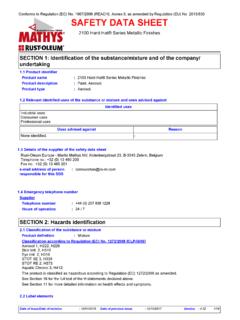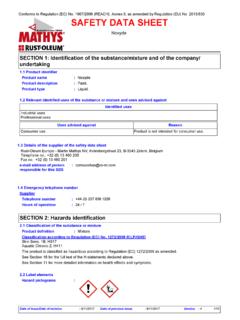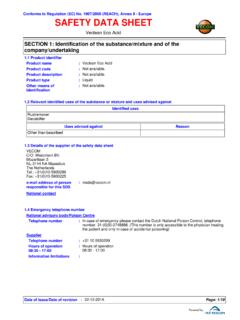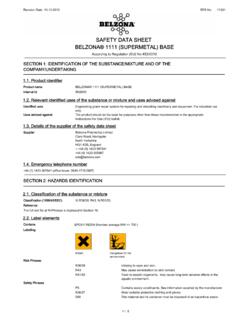Transcription of MSDS: 10-07 Asphalt Sealer Material Safety Data …
1 msds : 10-07 Asphalt Sealer Page 1 of 6 Revised 01/24/2018 Gloves Eye Protection Material Safety data sheet Section 1: PRODUCT AND COMPANY INFORMATION Product Name(s): 10-07 Industrial Asphalt Product Identifiers: 10-07 Industrial Asphalt , 10-07 Manufacturer: Information Telephone Number: Coco Paving Inc. (416) 633-9670 949 Wilson Avenue Emergency Telephone Number: Toronto, Ontario M3K 1G2 CANUTEC (613) 996-6666 Product Use: 10-07 industrial Asphalt is used as a protective coating in industrial applications. Section 2: COMPOSITION/INFORMATION ON INGREDIENTS Component Percent (By Weight) CAS Number OSHA PEL TWA (mg/m3) ACGIH TLV-TWA (mg/m3) LD50 (rat, oral) LC50 (rat, inhalation) Asphalt Cement (as Fume) 40-60 8052-42-4 NA NA NA Stoddard Solvent 35-50 8052-41-3 500 ppm 100 ppm NA NA Note: Asphalt is produced from high temperature vacuum distillation of crude oil. Composition varies depending on source of crude and specifications of final product.
2 It can contain trace amounts of sulfur, nitrogen and oxygen compounds as well as trace amounts of heavy metals. Different Asphalt grades may contain an anti-striping additive. Asphalt products can contain hydrogen sulfide, because it is naturally occurring in crude oil from which Asphalt is derived. Hydrogen sulfide can also be present as a by-product of Asphalt processing. Section 3: HAZARD IDENTIFICATION WARNING Flammable Liquid Hot product can cause burns. Irritant: Causes eye, skin and inhalation irritation. Toxic - Harmful by inhalation. Hot Product can release Hydrogen Sulfide gas. Use proper engineering controls, work practices, and personal protective equipment. Read msds for details. Emergency Overview: 10-07 is a black colored liquid that has a petroleum odor. Hot product will cause severe thermal burns. If burned by hot product, cool affected area immediately with cool water.
3 Seek medical attention. When heated, this product may release toxic hydrogen sulfide (H2S). Prolonged or repeated skin contact can cause drying of the skin which may produce irritation or dermatitis. Potential Health Effects: Risk of injury depends on duration and level of exposure. Eye Contact: Hot product will cause severe thermal burns. Eye contact with 10-07 liquid or vapors can cause moderate eye irritation, redness, and itching. Eye exposures require immediate first aid to prevent damage to the eye. msds : 10-07 Asphalt Sealer Page 2 of 6 Revised 01/24/2018 Skin Contact: Direct contact with hot 10-07 will cause severe thermal burns. Repeated or prolonged contact to 10-07 may cause redness, dry skin, discomfort, irritation, sensitivity and dermatitis. Inhalation: Hot 10-07 releases irritating fumes or vapors such as smoke, carbon dioxide, carbon monoxide, and unburned hydrocarbons.
4 Exposure to vapors may cause irritation of the nose and throat, and symptoms such as headache, dizziness, nausea, loss of coordination, and drowsiness. Hydrogen sulfide and other sulfur-containing gases can evolve from this product at elevated temperatures. Hydrogen sulfide can cause respiratory paralysis and death, depending on concentrations and duration of exposure. Do not rely on ability to smell vapors, since odor fatigue rapidly occurs. Effects of overexposure include irritation of the nose and throat, nausea, vomiting and signs of nervous system depression. Ingestion: Do not ingest 10-07 . Hot product will cause thermal burns. Ingestion may result in nausea, vomiting, diarrhea and restlessness. Aspiration (inadvertent suction) of liquid into the lungs must be avoided as even small quantities in the lungs can produce chemical pneumonitis, pulmonary edema/hemorrhage and even death.
5 Medical Conditions Aggravated by Exposure: Individuals with preexisting skin conditions can be aggravated by exposure. Section 4: FIRST AID MEASURES Eye Contact: For contact with product, flush with large amounts of cool water for at least 15 minutes, including under lids. Seek medical attention for burns and severe irritation. Skin Contact: Wash with cool water and a pH neutral soap or a mild skin detergent. Do not use solvents or thinners to remove product from skin. Seek medical attention for burns, rash, irritation, and dermatitis. For contact with hot product, immerse or flush skin with cold water for at least 15 minutes. Seek medical attention for burns. Inhalation: Move person to fresh air. Seek medical attention for discomfort or if coughing or other symptoms do not subside. Ingestion: Do not induce vomiting. If conscious, have person drink plenty of water.
6 Seek medical attention or contact poison control center immediately. Notes: The International Agency for Research on Cancer (IARC) has concluded that occupational exposures to oxidized Asphalt and their emissions during roofing operations are probably carcinogenic to Humans (Group 2A). IARC concluded that occupational exposures to hard Asphalt and their emissions during mastic Asphalt work are possibly carcinogenic to humans (Group 2B). IARC concluded that occupational exposures to straight-run Asphalt and their emissions during paving operations are possibly carcinogenic to humans (Group 2B). Section 3: HAZARD IDENTIFICATION (continued) msds : 10-07 Asphalt Sealer Page 3 of 6 Revised 01/24/2018 Section 5: FIREFIGHTING MEASURES Flashpoint & Method: C (102 F) Cleveland Open Cup. Firefighting Equipment: A SCBA is recommended to limit exposures to combustion products when fighting any fire.
7 General Hazard: Combustible liquid. Avoid breathing vapors. Upper/Lower Flammable Limit: LEL, 6 UEL. Auto-Ignition Temperature: 245 C (473 F) Combustion Products: Vapors form a flammable mixture with air. Toxic gases produced in fire, such as CO, CO2, and H2S. Explosion data : Sensitive to static charge Section 5: FIREFIGHTING MEASURES (continued) Extinguishing Media: Treat as a highly flammable fuel oil fire. Use appropriate extinguishing media for the size of the fire. Water spray and foam can cause frothing. Use of water on product above 100 C (212 F) can cause product to expand with explosive force. Specific Hazards: If tank, rail car or tanker truck is involved in fire, isolate for 800 meters (1/2 mile) in all directions; also consider initial evacuation for 800 meters (1/2 mile) in all directions. Shut off fuel to fire if possible to do so without hazard. Cool containing vessels with water spray in order to prevent pressure buildup, autoignition or explosion.
8 Do not flushing spilled product into sewers, streams or other bodies of water. Section 6: ACCIDENTAL RELEASE MEASURES General: Take proper precautions to ensure your own health and Safety before attempting spill control or clean-up. Remove all potential ignition sources. Isolate the area of the spill and restrict access. For small spills, soak up released 10-07 with inert absorbent Material , remove with shovels and place spilled Material into a container. Contain large spills with inert materials. Avoid using combustive absorbers such as sawdust. Transfer liquids and solid Material to suitable containers for recovery or disposal. Do not allow spills and cleaning runoff to enter drains, sewers, groundwater, drainage ditches or surface waters. Wear appropriate protective equipment as described in Section 8. Waste Disposal Method: Dispose of 10-07 according to Federal, State, Provincial and Local regulations.
9 Section 7: HANDLING AND STORAGE General: Handle with care and use appropriate control measures. Use appropriate grounding and bonding practices. Store in properly closed containers that are appropriately labeled and in a cool well-ventilated area. Do not expose to heat, open flames, strong oxidizers or other source of ignition. Do not cut, drill, grind or weld on empty containers since they may contain flammable residues. Significant concentrations of hydrogen sulfide (H2S) gas can be generated and accumulate in storage tanks and bulk transport compartments which may require additional precautions and procedures during loading and unloading. When opening covers and outlet caps on storage tanks, use face shield and gloves to avoid possible injury from pressurized product. Stay upwind and vent open hatches before unloading. Keep heating coils and flues in storage tanks, trucks and kettles covered with product.
10 Do not overheat. msds : 10-07 Asphalt Sealer Page 4 of 6 Revised 01/24/2018 Properly ground all conveyance systems. The potential exists for static build-up and static discharge when moving or mixing materials through a plastic, non-conductive, or non-grounded conveyance system. The static discharge may result in damage to equipment and injury to workers. Usage: Avoid contact with skin, eyes and clothing. Use additional precautions when handling hot Material . Maintain employee exposure levels below established regulatory limits. Do not allow hot product to contact skin. Ensure adequate ventilation. Use all appropriate engineering controls and Personal Protective Equipment (PPE) described in Section 8 below. Storage Temperature: Store away from all ignition sources, incompatible materials and open flames. Storage above 55 C or 122 F may affect product quality. Storage: Store in a cool, dry and well-ventilated area.
